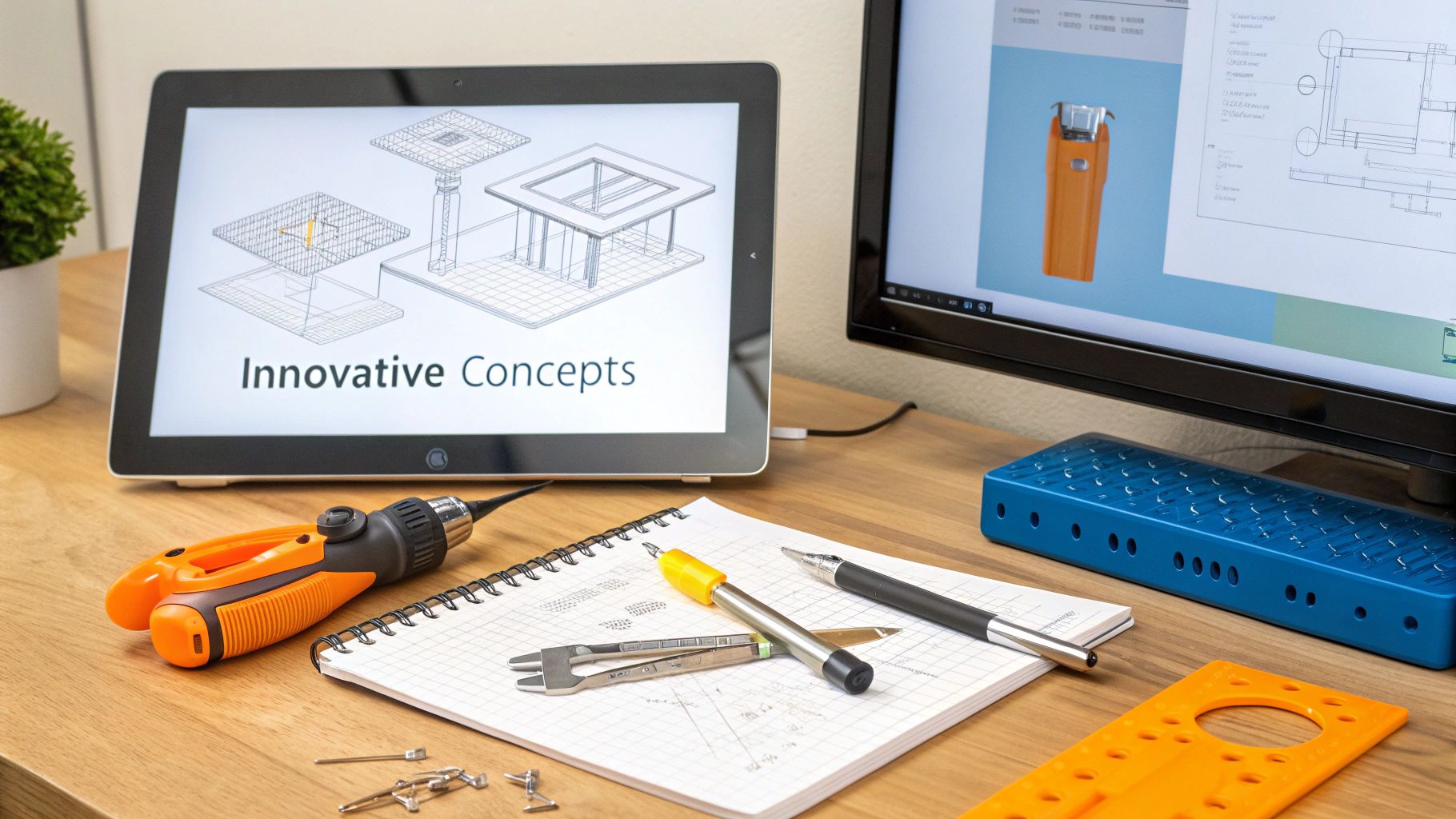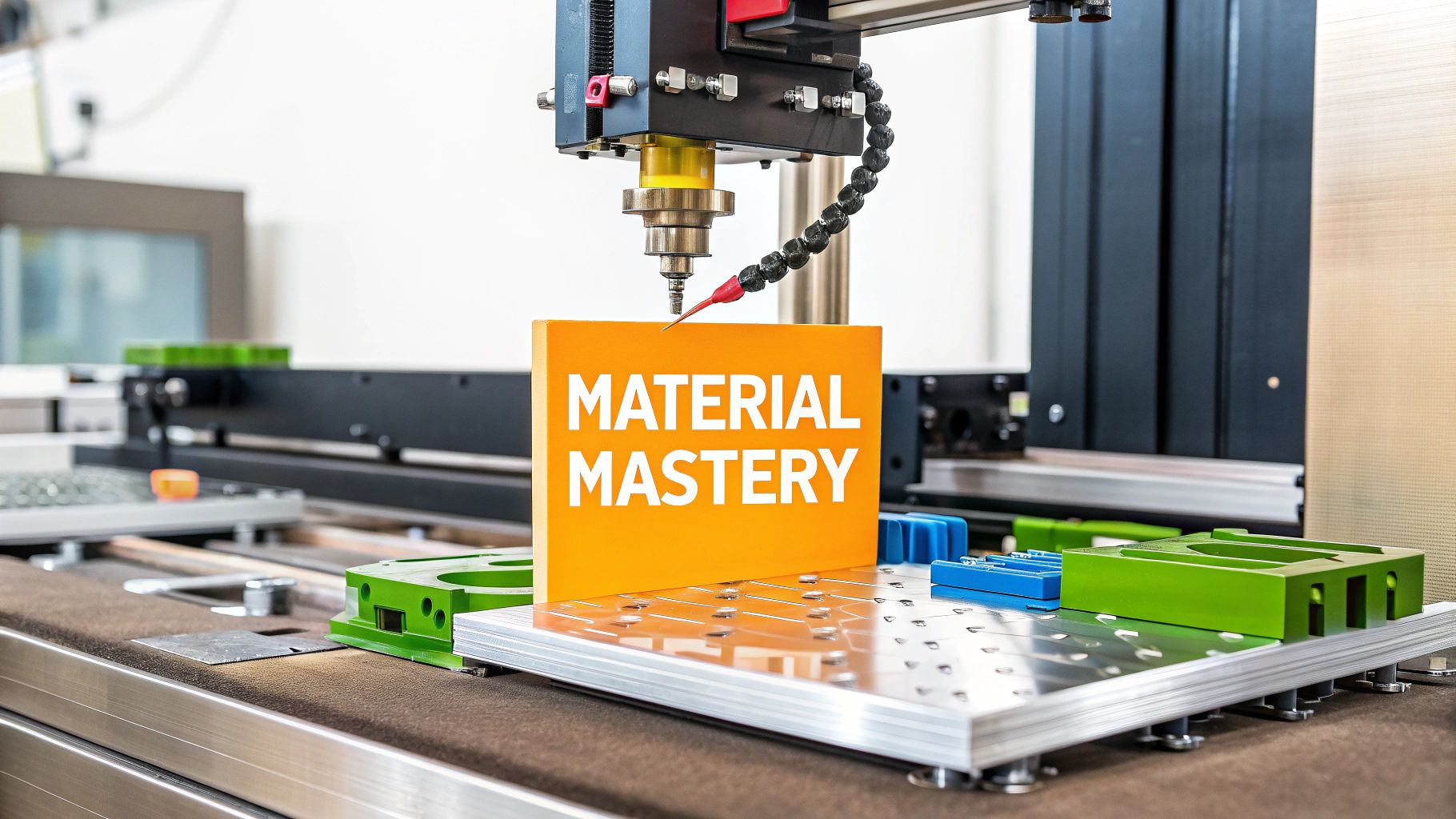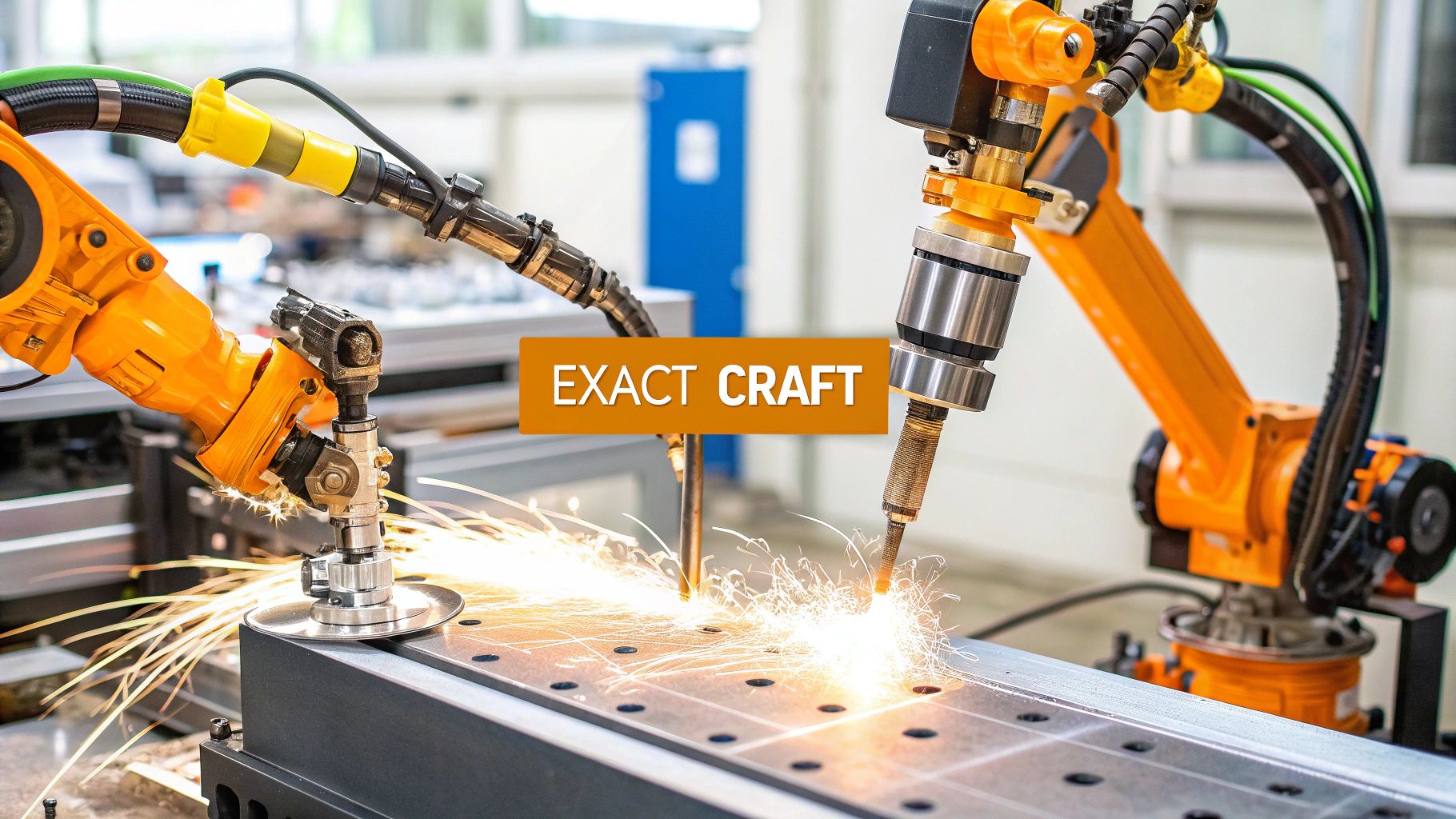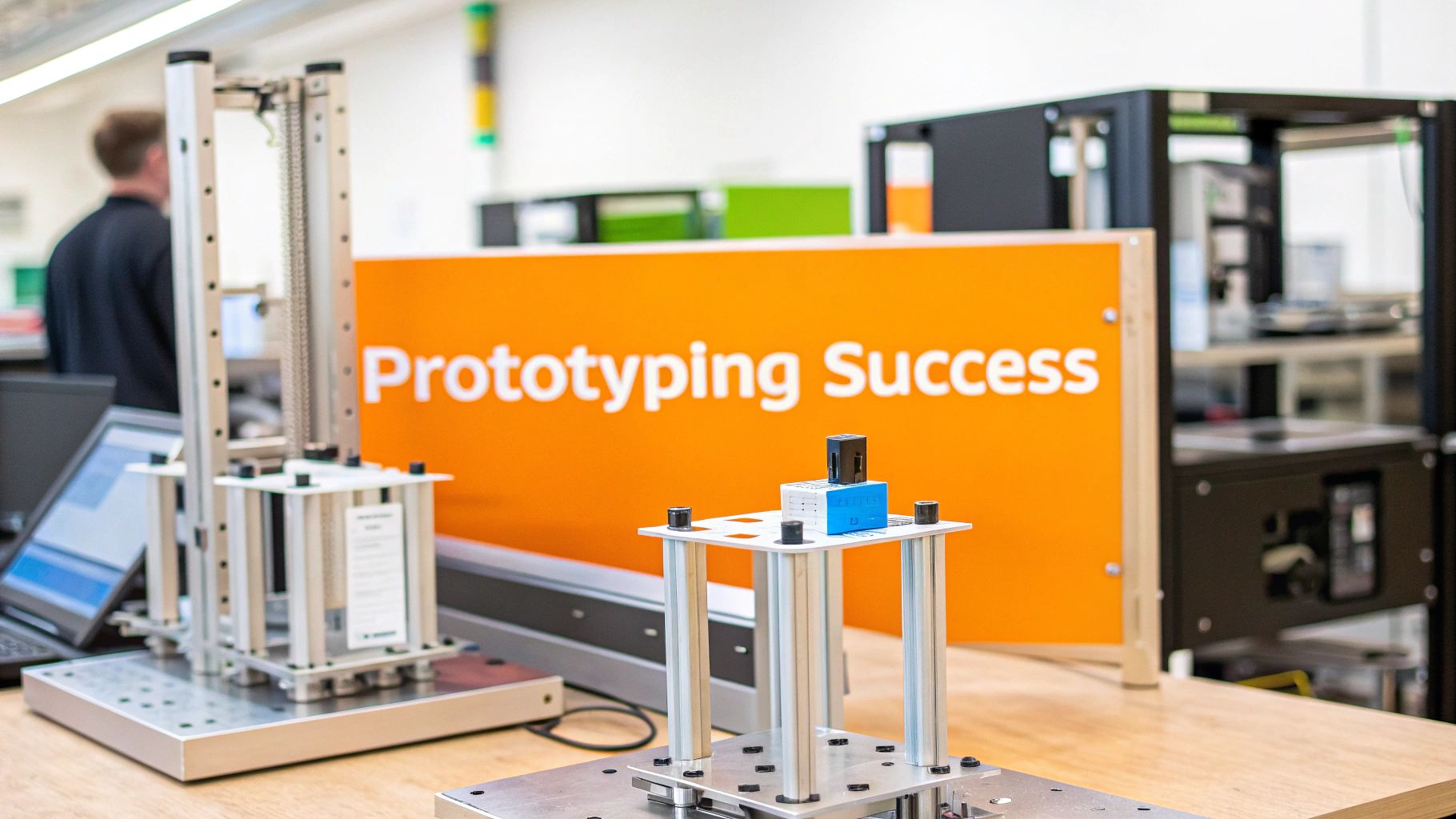The Evolution of Rapid Metal Prototyping

Rapid metal prototyping has revolutionized product development. Once limited to research facilities, these techniques are now integral to modern manufacturing processes. This shift is driven by the demand for faster, more adaptable production. This exploration traces the journey of rapid metal prototyping from its inception to its current state.
Rapid metal prototyping emerged from early research in the 1970s, with notable work at Bell Labs. Initially, these endeavors were primarily experimental. The landscape changed significantly with the introduction of the first commercially available systems in the mid-1980s. This pivotal moment broadened access, enabling a wider range of industries to adopt and further develop the technology.
The rapid prototyping market has seen remarkable growth, reaching $1.46 billion in 2023. Projections estimate a surge to $9.048 billion by 2030, reflecting a CAGR of 29.7%. This impressive expansion underscores the increasing demand for personalized products and the benefits of in-house prototyping. For those interested, further information can be found at: Laser Podcast Sitemaps and Rapid Prototyping Wikipedia.
Key Technological Advancements
Several key technologies have driven the evolution of rapid metal prototyping. Among the most significant are Selective Laser Melting (SLM) and Electron Beam Melting (EBM). These methods provide precise control over the building process, enabling the creation of complex shapes and intricate designs.
This level of detail was previously unachievable through traditional manufacturing. The precision offered by SLM and EBM has made rapid metal prototyping increasingly valuable across diverse industries.
Impact on Industries
The automotive and aerospace sectors, in particular, have benefited significantly from these advancements. SLM and EBM facilitate the rapid production of complex metal parts with exceptional accuracy.
For instance, intricate engine components or lightweight structural elements can be produced quickly and efficiently. This translates to faster design iterations and shorter production lead times, providing a substantial competitive advantage. These technologies offer both reduced production time and enhanced design flexibility.
Future Directions
The future of rapid metal prototyping is bright. Ongoing research and development are continually expanding the possibilities. New materials, refined processes, and increasingly accessible systems promise to broaden the applications and impact of this transformative technology. As the demand for customized products continues to grow, rapid metal prototyping will play a crucial role in shaping the future of manufacturing.
Cutting-Edge Processes Reshaping Metal Fabrication

Rapid metal prototyping is a core element of modern manufacturing. This section explores the key processes driving this advancement, focusing on their uses and how they address the changing needs of industries. These efficient methods allow the creation of complex metal parts with speed and precision.
Selective Laser Melting (SLM)
Selective Laser Melting (SLM) uses a powerful laser to melt and fuse metallic powders, layer by layer. This precise method enables the creation of intricate shapes with incredible detail. SLM produces high-performance parts with excellent mechanical properties, making it ideal for the aerospace and medical industries. In these fields, precision and material strength are crucial.
Direct Metal Laser Sintering (DMLS)
Direct Metal Laser Sintering (DMLS) is similar to SLM, using a laser to fuse metal powder. DMLS, however, sinters the powder instead of fully melting it. This results in parts with small pores, suitable for uses like rapid tooling and functional prototypes. DMLS supports a broader range of materials than SLM, giving more options for material selection. For example, DMLS can handle ceramics and some polymers in addition to metals.
Electron Beam Melting (EBM)
Electron Beam Melting (EBM) uses an electron beam in a vacuum chamber to melt and fuse metal powders. The vacuum minimizes oxidation and impurities, resulting in top-quality parts. EBM excels with reactive metals like titanium, commonly used in aerospace and medical applications. EBM ensures superior material purity for these critical uses.
Binder Jetting
Binder Jetting bonds metal powder particles with a liquid binding agent. The initial "green" part is then sintered for final strength and density. This method is faster and more budget-friendly than laser-based methods, attractive for high-volume production and complex shapes. The final products may have slightly lower mechanical strength compared to other rapid metal prototyping methods. Binder Jetting also works with a wide range of materials and complex designs. You might be interested in: How to master....
Choosing the Right Process for Your Needs
Choosing the right rapid metal prototyping method depends on several factors: the desired material properties, necessary precision, production volume, and budget. Each process has its own advantages and drawbacks. Understanding these is critical. For example, while SLM provides high precision and excellent material properties, it's more expensive than binder jetting, which focuses on speed and affordability.
The following table provides a helpful overview of these rapid metal prototyping methods.
Comparison of Rapid Metal Prototyping Technologies A side-by-side comparison of the main rapid metal prototyping technologies showing their capabilities, limitations, and ideal use cases.
| Technology | Process | Materials | Accuracy | Speed | Cost | Best Applications |
|---|---|---|---|---|---|---|
| Selective Laser Melting (SLM) | High-powered laser melts and fuses metallic powders layer by layer | Metals (e.g., titanium, aluminum, steel) | Very High | Moderate | High | Aerospace, medical, high-performance parts |
| Direct Metal Laser Sintering (DMLS) | Laser sinters metal powder | Metals, ceramics, polymers | High | Moderate | Medium | Rapid tooling, functional prototypes |
| Electron Beam Melting (EBM) | Electron beam melts metal powder in a vacuum | Reactive metals (e.g., titanium) | High | Moderate | High | Aerospace, medical, high-purity parts |
| Binder Jetting | Liquid binding agent joins metal powders, followed by sintering | Wide range of metals | Moderate | High | Low | High-volume production, complex designs |
This comparison highlights the trade-offs between different techniques. Selecting the right process ensures the final product meets your specific needs, whether it's the high precision of SLM or the speed and cost-effectiveness of binder jetting.
Material Selection: The Foundation of Success

Choosing the right material is the cornerstone of successful rapid metal prototyping. This section delves into the diverse world of metals and alloys commonly used in this process, exploring why some materials outperform others in specific applications. Understanding the properties of each material, from readily available aluminum and titanium alloys to more specialized options like tool steels and cobalt-chrome, is paramount.
The growth of additive manufacturing has significantly influenced the rapid prototyping materials market. Valued at $634.8 million in 2023, this market is projected to reach an impressive $2,827.3 million by 2032. This represents a substantial CAGR of 18.1%. This rapid expansion is driven by technologies like Selective Laser Sintering (SLS) and Selective Laser Melting (SLM), which maximize material efficiency, minimize waste, and ultimately enhance the performance of the final product. For a more in-depth analysis, check out the Rapid Prototyping Materials Market report.
Key Material Properties
Several crucial properties guide the selection of materials for rapid metal prototyping.
The strength-to-weight ratio is a primary concern, particularly in industries like aerospace and automotive where lightweight yet robust components are essential. Aluminum and titanium alloys are frequently chosen for their exceptional strength-to-weight ratios and inherent resistance to corrosion. Titanium's biocompatibility further expands its applications, making it well-suited for medical implants.
Thermal properties also play a vital role. A material's melting point, thermal conductivity, and thermal expansion coefficient influence its behavior during the prototyping process. Materials with high melting points are naturally preferred for high-temperature applications. Maintaining the correct thermal conductivity is crucial for uniform heating and cooling, preventing defects and ensuring a high-quality finished product.
Corrosion resistance is another key factor, especially for parts destined for harsh environments. Stainless steel is often selected for its ability to withstand corrosive elements. For extreme environments, specialized alloys like cobalt-chrome offer unparalleled protection. Similarly, biocompatibility is paramount for applications requiring materials that are inert within the human body, making titanium alloys a top choice due to their ability to integrate seamlessly with living tissue.
Advanced Materials and Alloys
Rapid metal prototyping goes beyond the usual suspects, employing a diverse range of specialized materials and alloys.
Tool steels, known for their hardness and wear resistance, are ideal for tooling applications. Cobalt-chrome alloys, as previously noted, perform exceptionally well in challenging environments due to their superior corrosion and wear resistance. Even precious metals like gold and silver find their place in specialized applications demanding high conductivity or other unique properties.
Pushing the boundaries of material science are custom alloys and metal matrix composites, specifically designed for additive manufacturing. These materials allow engineers to precisely tailor properties to meet specific design requirements, opening up a world of possibilities in rapid metal prototyping. This continuous development of new materials and processing techniques means increasingly complex and demanding projects can become a reality.
The Business Case for Rapid Metal Prototyping

Rapid metal prototyping offers significant technical advantages, but the financial benefits are equally compelling. This section explores how this technology provides a strong return on investment, leading to faster product development and lower production costs.
Reduced Development Time and Faster Time-to-Market
Rapid metal prototyping significantly speeds up product development. Creating physical prototypes quickly allows companies to identify and fix design flaws early. This iterative process can cut development times by 60-80%, enabling faster market entry. This speed is critical in competitive industries where being first often determines success.
Extensive testing and validation are also possible with rapid prototyping. This results in higher-performing and more reliable products.
Cost Efficiencies
Traditional manufacturing involves high tooling costs and long lead times. Rapid metal prototyping eliminates many of these expenses. Parts are created directly from digital designs, removing the need for expensive tooling. This drastically reduces upfront investment and ongoing production costs.
Rapid prototyping allows for quick design iterations. This minimizes material waste and reduces the need for costly revisions later. This efficiency translates to higher profitability. Advancements in materials science also contribute to market growth. A wider range of materials – including metals, polymers, and ceramics – can now be used efficiently. In 2021, the rapid prototyping market was valued at $2.5 billion. It's projected to reach $15 billion by 2031, with a CAGR of 20.4%. This versatility further enhances product customization and reduces overhead. More detailed statistics can be found at Allied Market Research.
Design Freedom and Complex Geometries
Rapid metal prototyping makes previously impossible geometries a reality. Complex internal features, intricate lattices, and customized designs are easily produced. This design freedom allows engineers to create innovative products with optimized performance. This opens doors to product differentiation and entirely new product categories. You might find the Sitemap Pages interesting.
Enhanced Competitiveness
Faster development, cost savings, and design freedom combine to create a significant competitive edge. Companies using rapid metal prototyping adapt better to changing market demands, introduce new products faster, and offer more customization. This agility is key in today's market.
Rapid metal prototyping creates high-performing products with optimized designs. Technologies like Selective Laser Melting (SLM) and Electron Beam Melting (EBM) produce parts with properties often exceeding those from traditional methods, further enhancing competitiveness. This capability lets companies push product performance boundaries.
The table below shows market growth across different industries:
Rapid Metal Prototyping Market Growth by Industry
This table showcases the adoption rates and projected growth of rapid metal prototyping in various sectors.
| Industry | Current Market Size ($M) | Projected Growth (%) | Key Applications | Primary Materials Used |
|---|---|---|---|---|
| Aerospace & Defense | Data unavailable | Data unavailable | Functional prototypes, tooling | Titanium, Aluminum, Nickel alloys |
| Automotive | Data unavailable | Data unavailable | Design validation, tooling | Steel, Aluminum, Magnesium |
| Medical & Dental | Data unavailable | Data unavailable | Implants, prosthetics, surgical instruments | Titanium, Stainless steel, Cobalt-chrome |
| Consumer Goods | Data unavailable | Data unavailable | Prototypes, customized products | Plastics, Metals, Ceramics |
| Industrial Manufacturing | Data unavailable | Data unavailable | Tooling, jigs, fixtures | Steel, Aluminum, Tool steel |
Note: Market size and growth data are unavailable at the industry-specific level in the provided source. More research is needed to obtain this granular data.
Industry Transformations: Real-World Success Stories
Rapid metal prototyping is reshaping industries by offering more than just speed. It's a catalyst for innovation, impacting fields from aerospace to healthcare. Let's explore how this technology delivers tangible improvements and valuable insights for future projects.
Aerospace: Lighter, Stronger, Faster Components
The aerospace industry requires components that are both lightweight and exceptionally durable. Rapid metal prototyping empowers manufacturers to create these complex parts, often exceeding traditional performance benchmarks.
For instance, combining titanium alloys with Selective Laser Melting (SLM) allows for the production of intricate, lightweight structures. This reduces fuel consumption without compromising safety, resulting in more efficient aircraft and spacecraft.
Automotive: Speeding Up Development
Rapid metal prototyping has significantly shortened development cycles in the automotive industry. Processes that once took years can now be completed in months. This accelerated pace facilitates rapid design iterations and faster time-to-market.
Moreover, this technology enables the creation of high-performance parts with complex geometries, previously impossible with traditional methods. This opens up exciting possibilities for advanced automotive design and engineering.
Medical: Personalized Healthcare Through Precision
In the medical field, rapid metal prototyping is transforming patient care. The creation of patient-specific implants and surgical instruments has reached unprecedented levels of precision.
This personalized approach leads to improved patient outcomes and shorter recovery times. For example, craniomaxillofacial implants can be precisely tailored to a patient's unique anatomy. This results in a better fit and enhanced functionality, a level of personalization previously unattainable.
Case Study: Streamlining Surgical Instrument Production
A compelling success story demonstrates the impact of rapid metal prototyping on surgical instruments. A complex instrument, once challenging and time-consuming to manufacture traditionally, was redesigned for rapid metal prototyping using stainless steel.
The result was a 65% reduction in production time and a 40% cost savings. Furthermore, the redesigned instrument boasts improved ergonomics, enhancing its value for surgeons.
Key Lessons for Successful Implementation
These real-world examples offer valuable takeaways for successfully incorporating rapid metal prototyping:
-
Material Selection: Choosing the right material is paramount. Titanium, with its biocompatibility, is ideal for medical implants, while aluminum's strength-to-weight ratio benefits aerospace applications.
-
Technology Choice: Different rapid metal prototyping processes – SLM, Direct Metal Laser Sintering (DMLS), Electron Beam Melting (EBM), or Binder Jetting – offer unique characteristics. The optimal choice depends on the desired material properties, part complexity, and cost.
-
Design Optimization: Designing specifically for additive manufacturing unlocks its full potential. Engineers can create complex internal structures and lattices, maximizing performance and efficiency.
By understanding these factors and applying these lessons, businesses can harness the power of rapid metal prototyping. This facilitates the creation of innovative products, streamlined production cycles, and ultimately, improved outcomes across diverse industries.
Implementation Roadmap: From Concept to Capability
Successfully integrating rapid metal prototyping requires careful planning. This practical guide outlines the essential steps for implementation, from assessing your needs to scaling your operations.
Assessing Your Needs and Capabilities
The first step is to thoroughly evaluate your current manufacturing processes. Identify areas where rapid metal prototyping can offer improvements. Consider your specific applications, existing equipment, and long-term objectives. For example, if you produce complex parts with long lead times, rapid metal prototyping could offer significant advantages.
This initial assessment should also include a realistic budget analysis. While rapid metal prototyping offers long-term cost savings, the initial investment in equipment and training can be substantial. Understanding these costs is crucial for successful implementation.
Technology Selection
Choosing the appropriate rapid metal prototyping technology is critical. Each method has its strengths and weaknesses. Consider factors like material compatibility, required precision, production volume, and budget constraints. Some popular methods include Selective Laser Melting (SLM) and Binder Jetting.
For instance, SLM excels at producing high-precision parts with excellent material properties, making it ideal for aerospace applications. However, Binder Jetting offers greater speed and affordability, making it suitable for high-volume production.
Staffing and Training
Rapid metal prototyping requires specialized skills. Assess your current team's expertise and identify any skill gaps. Addressing these gaps might involve training existing employees or recruiting specialists.
Strategic partnerships with external service providers can also be a valuable resource. This is particularly true during the initial implementation phase. Effective training programs should cover the operation of the chosen technology, design optimization for additive manufacturing, and quality control procedures.
Implementation Challenges and Solutions
Implementing rapid metal prototyping can present several challenges. Developing robust quality control systems is essential to ensure consistent part quality. Design optimization for additive manufacturing often requires a shift in thinking from traditional manufacturing methods.
Creating efficient post-processing workflows, such as heat treatment and surface finishing, is also crucial. Addressing these challenges often requires a collaborative approach. Engaging with experienced industry professionals and seeking expert advice can provide valuable insights and practical solutions.
Scaling Your Capabilities
Once your initial implementation is successful, consider how to scale your rapid metal prototyping capabilities to meet growing demand. This may involve investing in additional equipment, expanding your team, or refining your workflows.
Establishing clear success metrics is important. Examples include reduced lead times, decreased production costs, or increased design iterations. Tracking these metrics allows you to monitor progress and identify areas for further improvement. Industry best practices offer valuable guidance for scaling your operations effectively.
A well-defined roadmap ensures a smoother transition to rapid metal prototyping. From initial assessment to scaling your capabilities, each step contributes to maximizing the benefits of this powerful technology.
Ready to harness the power of lasers for your business? Explore the latest advancements in laser technology and their applications in manufacturing at Laser Insights China. Gain valuable knowledge and insights to propel your business forward.

